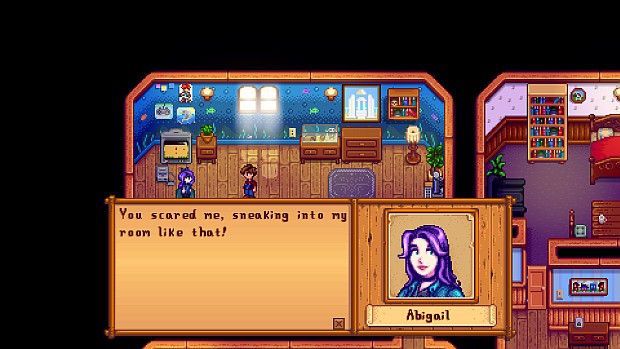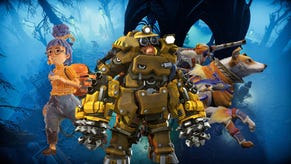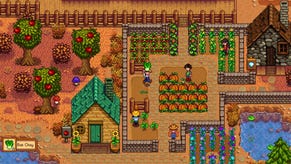Wot I Think: Stardew Valley
Better than Harvest Moon?
After my second nearly sleepless night, I think it's safe to say that I'm hooked. Only this isn't the "just one more turn" of Sid Meier's Civilization, it's the "just one more day" of Stardew Valley [official site], a honkey-tonk love letter to the Harvest Moon series. But Stardew Valley isn't trapped by its obvious affections for Harvest Moon. It uses them as a foundation to expand from, to create something that is as rewarding as stepping foot outside your door to see a crop of bulbous melons ready to harvest. Here's wot I think:
Like Harvest Moon, Stardew Valley is a rather on-the-nose commentary about abandoning the relentless pace of city life for the rural charms of the countryside. But Stardew Valley wears its message without subtlety as the introduction sticks you in a cubicle confronting another day in a lifetime of stale corporate existence. Seeking a way out, you open an old letter from your grandfather that foretells of this quarter-life crisis and offers you an escape by inheriting his farmstead and embracing a more rewarding life. Before you know it, you'll be stepping off the bus and into the rustic charms of Pelican Town.
From day one, Stardew Valley wasted no time with upending a bucket of possibilities into my lap, and I felt overwhelmed by the amount of ways I could spend a day once the training wheels were taken off in the first month. Time and stamina were my greatest enemy, and there's a satisfying challenge to planning routines while working towards larger objectives like upgrading my home and tools.
There's a really great feeling of progression to Stardew Valley. Your farming enterprise will start out humble, but with a little effort and some strategy, your business will blossom into a titan of industry. Pumping out a steady stream of produce, artisan goods, and whatever else you can pick up that isn't nailed down to sell off feels rewarding when you remember the humble crops you started with.
Each money-making activity you pursue will filter into one of several branches of progression like foraging, farming, or mining. You’ll level up as you keep playing, becoming more proficient while also unlocking new crafting recipes.
Crafting is a huge part of being successful in Stardew Valley, as just shipping off raw produce is rarely ever the most economical way of making a living. Once you unlock more crafting blueprints, you can expand the operations on your farm in a multitude of ways. By the end of my first summer, I was churning out jars of mayonnaise and jelly, tending to bee hives, tapping trees for syrup, feeding livestock, and spending the evening casting my fishing line in the ocean. Though I always felt inspired to move at a decent clip throughout the day, spending a quiet evening taking in the crash of waves while fishing feels genuinely relaxing. Stardew Valley's romanticism of farm life is captivating.
Unlike Harvest Moon, which tends to preach that hard work in itself is a reward, Stardew Valley is absolutely giddy about patting you on the back every step of the way. Whether it's the bounty from a big crop or saving up for an exciting new addition to your farm, there is a constant stream of rewards to look forward to.
The amount of farmland available is staggering, and I cannot imagine how anyone could put all of that space to use without turning Stardew Valley into the most stressful time management game ever devised. There isn't a whole lot of automation that you can set up to help you either. Sprinklers can be crafted to water your crops, but you're still going to need to get your hands dirty on a daily basis. Overextending yourself can have consequences, like the time I used all my money to plant a massive crop of blueberries and then spent the rest of summer resenting having to care for them each day.
Your farm isn't the only area with a lot of space, and that can feel like a curse when you set off to visit your neighbours. Pelican Town is almost too spread out, and getting from place to place can begin to feel like a chore—not the good kind. This is perfectly exemplified in the public bathhouse, which features two empty and functionally pointless rooms you have to walk through just to get to the pools and restore your stamina—something I came to hate when I was racing against the clock to get something done and had to waste precious seconds.
Finding villagers as they mosey about their days can also be a pain. There's no indication of where they might be, so you're best bet is to memorize their schedules or find a written guide online—neither feeling like adequate solutions to a problem Harvest Moon solved a few games ago by indicating which area of the map villagers are currently in.
Where Stardew Valley really comes alive is in the interactions with the local townsfolk, a much adored Harvest Moon tradition that Stardew Valley mimics to great effect. Each of the twenty-plus residents of Pelican Town are distinctive personalities that you can befriend, opening up deeper possibilities and new twists to the formula like shacking up and getting married. While there are tangible benefits to playing nice with all your neighbors, the greatest reward comes from slowly peeling back the layers of their lives and understanding them on a deeper level. Here is where Stardew Valley reveals that it isn't just another Harvest Moon clone, as the way it treats some of these relationships can feel poignant and self-aware in ways that Harvest Moon never has.
There's themes of corporatism crushing small business, like the clashes between Pierre's general store and the Joja supermarket just a few doors down, and even of homelessness. Late one night I stumbled upon Linus, a homeless man, rifling through the trash. We had a brief conversation where I was given the option to sympathize with or chastise him. Given how I had already started taking a liking to Linus, the interaction really struck a chord with me because it wasn't already awful enough that he was caught in such a situation, he now felt the need to justify himself to me.
I also can't decide if it was intentional that Linus's tent is the only personal space in Stardew Valley that you can enter without first receiving permission from the owner. Needless to say, I've started sparing a few crops from every harvest for him.
Where Harvest Moon seems to be almost puritanical in its treatment of relationships, Stardew Valley feels much more grounded in honesty. One day mayor Lewis sent me a letter asking if I could—very discreetly—find his purple shorts that he had misplaced, and I was a bit confused why he seemed so distressed over them. That was until I found the shorts in Marnie's bedroom, the unmarried livestock vendor who had been loudly complaining about being single at the last village fair. They weren't just shorts, I realized, they were underwear.
By taking the time to read between the lines of each character's mundane life, a sparkling subtext begins to form that transformed them from pixels on a screen into endearing personalities that live on in my head. Watching those character arcs evolve as I play is a richly rewarding experience.
Taking a step back, I'm sometimes a bit mystified that everything Stardew Valley was assembled by just one person over a number of years. There's a coherence of design that balances so many moving parts and activities, tempting you with each of them while never allowing you to accomplish all of them in a day, giving Stardew Valley a great sense of anticipation for each new morning. This boundless enthusiasm is further driven by a wonderful soundtrack and pixel art that evokes nostalgia while feeling well suited to the rest of Stardew Valley's simple charms. My only complaints with the art is that certain characters don't always feel as expressive as their dialogue implies. Also, the darkening effect of nighttime cranks the contrast up to gross levels, making being out after dark plain ugly.
Stardew Valley is the rare kind of imitation that breaks free of the boundaries of its inspiration, becoming more than just a clone but an experience that thrives independent of its origins. I suspect some of these feelings come from a deep familiarity with Harvest Moon, thus an appreciation for the subtle ways Stardew Valley differs. But that doesn't stand in the way of the fact that Stardew Valley is a great game in its own right; one that might very well steal the floral crown Harvest Moon has been wearing for so long.
Stardew Valley is out now for Windows via Steam, GOG and Humble.






















